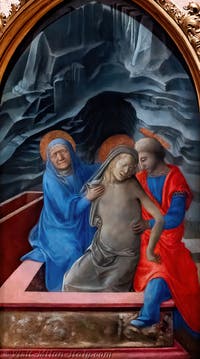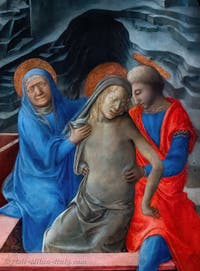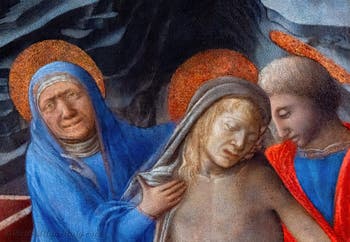Museums Ambrosiana | Castello Sforzesco | Poldi Pezzoli
Poldi Pezzoli Artists | Location | Opening Hours Tickets | Authorizations
Artists Bellini | Botticelli | Canaletto | Carriera | Cranach | Daddi | Francesca | Giordano | Guardi | Lippi F. | Lotto | Luini | Mantegna | Montagna | Memling | Palma | Pinturicchio | Pollaiolo | Raphael | Tiepolo | Titian | Weapons Room
Filippo Lippi “The Pietà- Imago Pietatis or Man of Sorrows or Christ of Pity” Poldi Pezzoli Museum in Milan in Italy
Filippo Lippi (1406 – 8 October 1469) “The Pietà- Imago Pietatis or Man of Sorrows”
Painting - Tempera on wood (57.5 x 32 cm) 1435 - 1440
Filippo Lippi, The Pietà We are witnessing the painful resurrection of Christ against the dark and gloomy background of a cave carved into the black rock.
This cave refers to the tomb dug into the rock by Joseph of Arimathea to place the body of Christ.
Filippo Lippi made this return to Christ's life difficult, whose grey cadaveric skin is barely lighter than the rocky bottom.
His body has the grey colour of its shroud, only his face is beginning to come alive, and his hair is the only colourful touch of this corpse slowly coming back to life.
A resurrected body with entirely smooth skin that shows no trace of the violence he suffered before he died.
Lippi painted a striking image of the death of Christ, “Imago Pietatis”.

Filippo Lippi, The Pietà The Imago Pietatis, or “Man of Sorrows” or “Christ of Pity”, represents Christ naked, upright and tottering.
In this sense, this “Man of Sorrows” from Lippi is a good illustration of the hardship of this resurrection of Christ.
We see Christ barely emerging from death; his body is heavy, and he does not yet control it.
Saint John the Evangelist helps him by supporting him with both hands by the waist, while the Virgin Mary holds his head, which he cannot straighten while restraining his shoulder to prevent him from falling forward.

Filippo Lippi, The Pietà Christ's hands and his arm, which is still inert, indicate his great weakness.
Her right hand is placed on Marie's shoulder, almost transparent under the blue fabric, while her left hand is curled up, her fingers having not yet fully recovered.
Mary's face expresses an intense emotion of joy and victory over the tears and sadness of mourning.
At the same time, the reaction of Saint John the Evangelist is internalized, which Fra Filippo Lippi translated by bowing his head to him.
Some historians believe that this work by Filippo Lippi was commissioned by Cosimo the Elder to donate it to Pope Eugene IV, who was in Florence then.
Artists Bellini | Botticelli | Canaletto | Carriera | Cranach | Daddi | Francesca | Giordano | Guardi | Lippi F. | Lotto | Luini | Mantegna | Montagna | Memling | Palma | Pinturicchio | Pollaiolo | Raphael | Tiepolo | Titian | Weapons Room
Poldi Pezzoli Artists | Location | Opening Hours Tickets | Authorizations
Museums Ambrosiana | Castello Sforzesco | Poldi Pezzoli
Back to Top of Page

